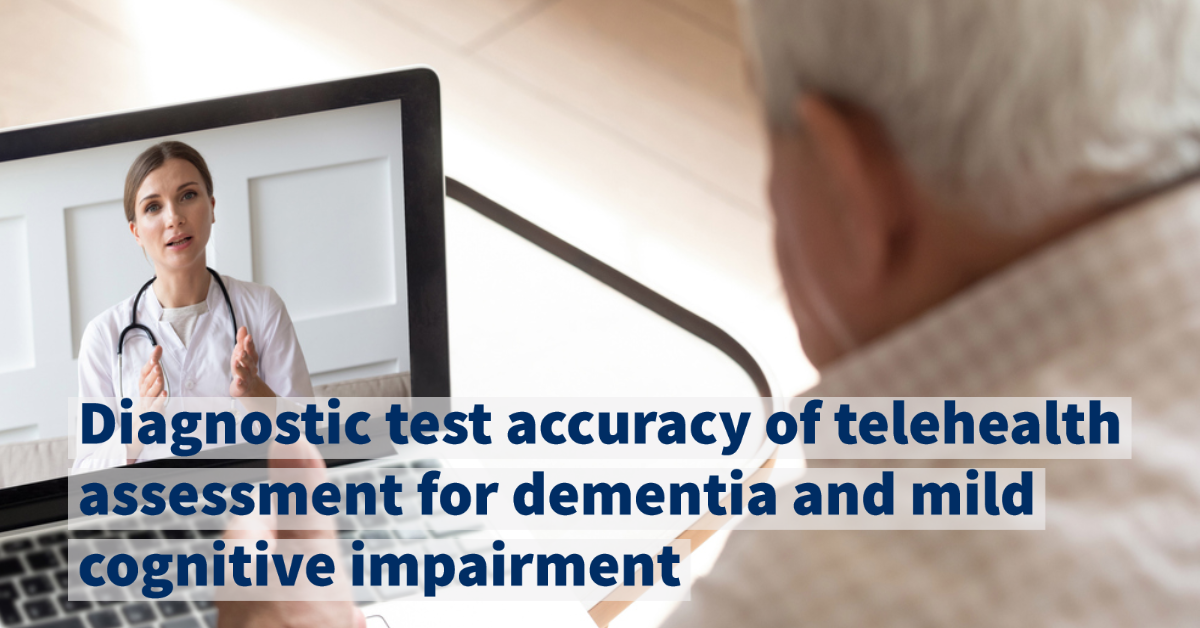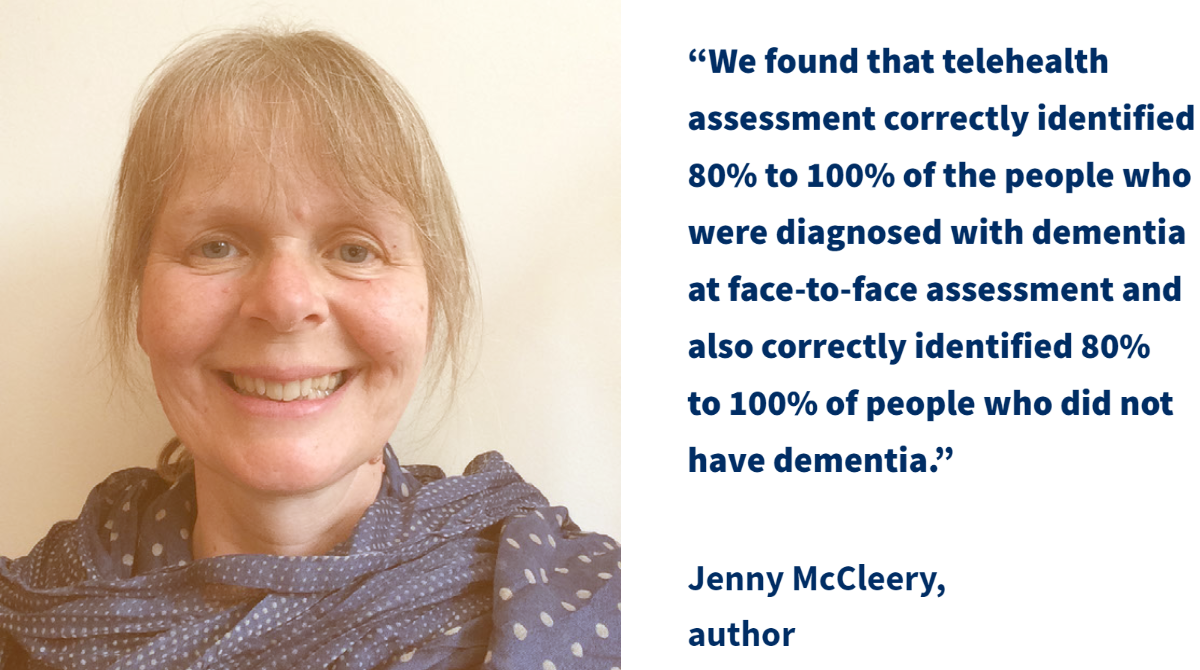
Recently Cochrane Dementia and Cognitive Improvement published 'Diagnostic test accuracy of telehealth assessment for dementia and mild cognitive impairment.' We spoke with Dr Jenny McCleery, one of the authors of this Cochrane review, a Consultant Psychiatrist at Oxford Health NHS Foundation Trust, and the Joint Coordinating Editor, of Cochrane Dementia and Cognitive Improvement Group. Find out about the findings, how it came about, and how the pandemic prompted this review.
Can you tell us about this Cochrane Review? We'd love to know how it came about and what drew to you the topic.
We chose to write this review when we did because of the COVID-19 pandemic. All the authors work in NHS clinical services. Some of my regular work is in a community memory clinic, where we assess older people with suspected dementia. Of course, not every patient gets a diagnosis, but most commonly we diagnose dementia or mild cognitive impairment (MCI), which is a less severe condition in which the patient has some problems with thinking and/or remembering, but can still manage all their daily activities independently. In our service, a patient usually has some investigations before the appointment (blood tests and often a brain scan), and then spends 1-2 hours in clinic being interviewed and examined before a doctor makes a diagnosis.
Once the pandemic hit, there was an immediate suspension of all non-urgent face-to-face contacts and memory clinics were left scrabbling to find alternative ways to keep their services going. One way to do this was to offer telehealth assessments, that is assessments conducted using telephone or videoconferencing systems where the patient and the doctor making the diagnosis did not meet in person. Although it was clear that this would not be an ideal solution for many older people with suspected dementia, some patients were willing to try this approach.
This brought up lots of questions. One of these was whether patients could be confident that we would be able to make accurate diagnoses of dementia or mild cognitive impairment using telehealth methods. We knew there was some literature about this, mainly from higher income countries where there is an interest in providing services to remote and rural areas. We thought it would be important to look at the work that had been done in those areas to see what was known about accuracy of telehealth diagnoses.
Although we were motivated chiefly by the pandemic, there are other very good reasons to be interested in the use of telemedicine in dementia services. Worldwide, a large majority of people with dementia have not had a formal diagnosis. This affects not only their own and their families’ knowledge about the cause of their symptoms, but also their access to support services and treatments. It also means that governments and health and social care providers lack essential information to plan services for their populations. The World Health Organization (WHO) has set a target that by 2025 at least 50% of the estimated number of people with dementia in 50% of countries should have had a diagnosis. This target will be challenging in many countries, and innovative ways to increase access to assessment will be needed, particularly for older people living outside urban centres. Telehealth might be one part of a solution.

What is included in the review?
We looked for studies in which participants had two assessments for dementia within four weeks of each other - one assessment using telehealth methods and one standard face-to-face assessment. The face-to-face assessment was the ‘reference standard’, that is, it was assumed to give the correct result, and we then looked to see how well the telehealth assessment (the index test) agreed with it. These kinds of studies are known as cross-sectional diagnostic test accuracy studies.
We knew that in remote and rural services, the telehealth models used are not necessarily very ‘pure’. Even if the specialist making the diagnosis does not meet the patient in person, it is quite common for local healthcare professionals, e.g. nurses, to meet the patient to gather some information or do some of the examination in advance. Although these models might not be very useful in a pandemic situation, we included them because of the wider importance of telemedicine for dementia care in future.
We only found three studies with 136 participants to include in the review. Two studies (20 and 100 participants) took place in community settings in Australia and one study (16 participants) was conducted in veterans' care homes in the USA. All the telehealth assessments were done using videoconferencing systems. Only the smaller Australian study (20 participants) used a pure telehealth model in which all aspects of the assessment were done remotely. In the other two studies, quite a lot of information was gathered in person by nurses and used in both diagnostic assessments; this could make it more likely for the researchers to find close agreement between the in-person and telehealth diagnoses.
How can people with dementia, their carers and clinicians use the review to help them with their decision making?
The conclusions we could draw were limited by the very small amount of evidence and the application of our results to the pandemic situation was limited by the type of telehealth model used in the included studies.
In as far as they went, the results were reassuring for the accuracy of telehealth assessment. We found that telehealth assessment correctly identified 80% to 100% of the people who were diagnosed with dementia at face-to-face assessment and also correctly identified 80% to 100% of people who did not have dementia. Only one study (100 participants) attempted to diagnose MCI. In this study, 71% of participants who had MCI were correctly identified using telehealth assessment, as were 97% of those who had any cognitive diagnosis (either MCI or dementia), but only 22% of those who had no cognitive diagnosis at face-to-face assessment. However, the latter result was especially uncertain because there were so few patients in this category.

It is important to note that diagnoses of dementia and MCI made by two specialists seeing patients face-to-face will not show 100% agreement. Therefore, perfect agreement between telehealth and face-to-face assessments cannot be expected. The larger Australian study was interesting because it also included a group who had two face-to-face assessments; the authors found that agreement between telehealth and face-to-face assessments was no worse than agreement between two face-to-face assessments.
Therefore, although there was less evidence than we would like to have found, we did not find any reason to think that dementia diagnoses made by clinicians using videoconference assessments were likely to be inaccurate.
What would you like to see happen next to build on this study?
There are many more questions to be answered. We have not touched so far on the diagnosis of different subtypes of dementia, which is something else clinicians in memory clinics are usually trying to achieve. Although we intended to study accuracy of subtype diagnosis, we did not find any data on this at all. That would be something very important to study if telehealth were to remain in widespread use.
A few established telehealth dementia services, again mainly in remote and rural areas, have published data on the acceptability of the telehealth model to their populations. The factors affecting acceptability are likely to vary a lot from place to place, so local research on acceptability, equity and barriers to use is really important to inform service developments.
There is also clearly a need to compare different telehealth models on accuracy, acceptability, cost effectiveness and sustainability measures.
Although we were only looking at the accuracy of diagnosis in this review, patients and carers are of course also interested in the quality of ongoing support after a dementia diagnosis. Whether telehealth support services are effective is another whole area for interesting research.
